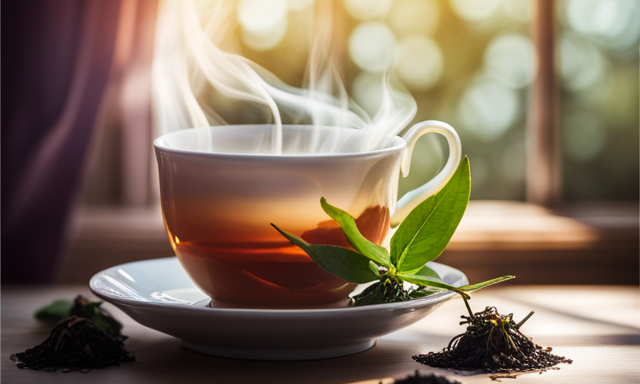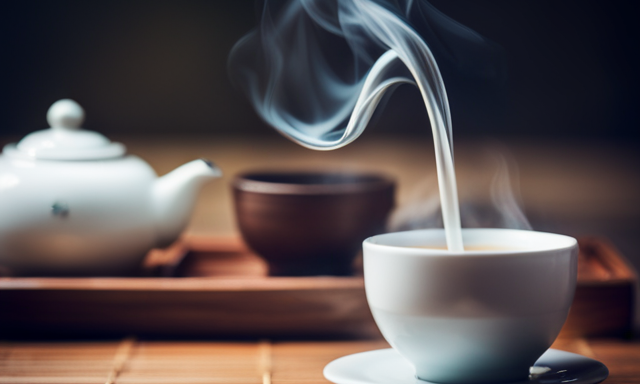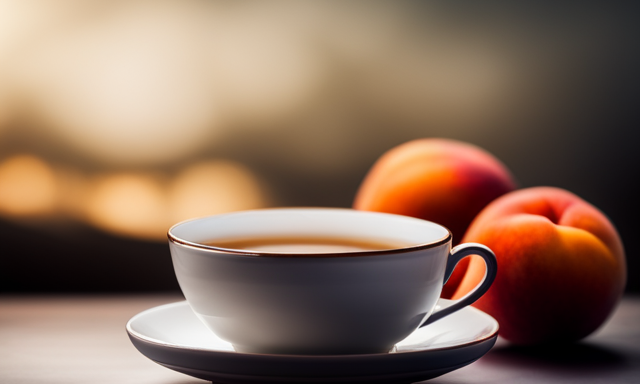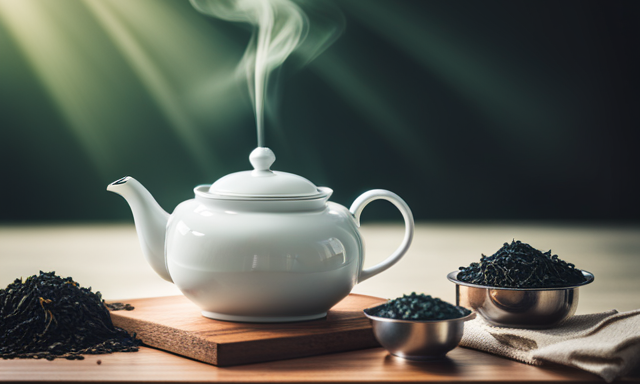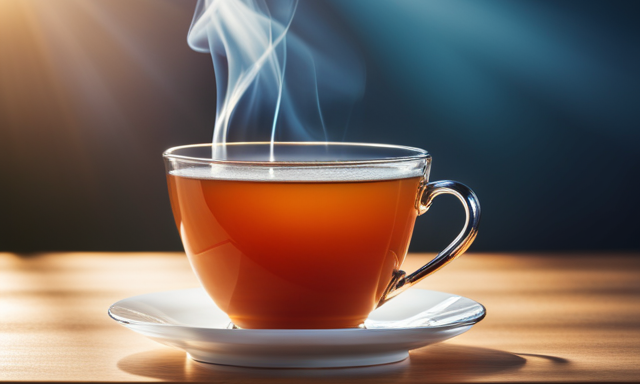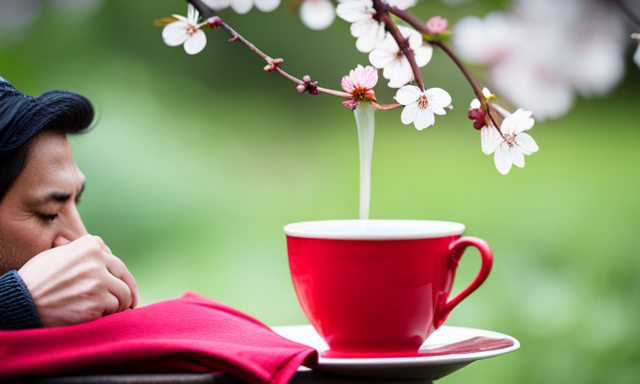Have you ever wondered what kind of tea oolong tea really is? Well, let me guide you on a journey to discover the fascinating world of oolong tea.
With its origins deeply rooted in Chinese culture, oolong tea is a unique and captivating beverage that offers a plethora of benefits. From its distinct characteristics to its potential health advantages, oolong tea has gained popularity for good reason.
In this article, I will delve into the origins of oolong tea, explore its different types, and provide tips on how to brew the perfect cup. Additionally, I will share insights on pairing oolong tea with food, its potential role in weight loss, and where to find the highest quality oolong tea.
So, grab a cup of your favorite tea and join me as we unravel the secrets of oolong tea together.
Key Takeaways
- Oolong tea is a beloved and sought-after tea variety in China, known for its distinct flavors and health benefits.
- Taiwan has a rich tea culture and is known for producing high-quality oolong tea with unique characteristics and flavors.
- Flavored oolong blends are popular, adding a burst of flavor to the traditional oolong experience by infusing natural extracts or dried fruit pieces.
- Oolong tea can be paired with a wide range of foods, complementing seafood, salads, grilled meats, chocolate desserts, cheese, and roasted vegetables, adding complexity to savory and sweet dishes.
The Origins of Oolong Tea
The fascinating history of oolong tea will transport you to ancient China, where this exquisite tea originated. Oolong tea holds immense cultural significance in Chinese society and has been an integral part of their traditions for centuries. It is not just a beverage, but a symbol of hospitality, respect, and harmony.
The Chinese believe that oolong tea has numerous health benefits and plays a vital role in traditional Chinese medicine. Its consumption is believed to promote digestion, boost metabolism, and even aid in weight loss. Oolong tea’s unique characteristics, such as its partially oxidized leaves and diverse flavors, make it stand out among other tea varieties.
With its rich history and cultural importance, oolong tea continues to captivate tea enthusiasts worldwide. Now, let’s delve into the unique characteristics of oolong tea.
The Unique Characteristics of Oolong Tea
When it comes to oolong tea, there are a few key characteristics that set it apart from other types of tea.
One of the most intriguing aspects is the semi-oxidization process it undergoes, which gives it a unique flavor profile. This process allows oolong tea to have a delicate balance between the freshness of green tea and the richness of black tea.
Additionally, oolong tea is known for its complex flavor profiles and enticing aromas, ranging from floral and fruity to toasty and nutty.
These qualities make oolong tea a truly distinctive and captivating beverage.
Semi-Oxidization Process
During the semi-oxidization process, oolong tea leaves slowly unfurl and release their rich, aromatic flavors. This oxidation process is a crucial step in oolong tea production, as it allows the leaves to undergo partial fermentation.
The leaves are carefully bruised or rolled, exposing their enzymes to the air. As a result, the tea leaves start to oxidize, but only to a certain extent. This delicate balance of oxidation gives oolong tea its unique characteristics, sitting between green and black teas.
The semi-oxidization process allows oolong tea to achieve its distinctive flavor profiles and aromas, ranging from fruity and floral to toasty and nutty.
Transitioning into the next section, the combination of semi-oxidization and tea leaf processing results in a wide variety of flavor profiles and aromas in oolong tea.
Flavor Profiles and Aromas
As the leaves slowly unfurl and release their rich, aromatic flavors, one can imagine a symphony of fruity and floral notes dancing in the air. Oolong tea is known for its complex flavor profiles, which can range from sweet and fruity to earthy and roasted.
The taste of oolong tea can vary depending on factors such as the oxidation level, the processing method, and the origin of the tea leaves. Some oolong teas have a peachy or apricot-like sweetness, while others exhibit a more robust taste with hints of honey or caramel. These diverse flavors make oolong tea a delight for the senses, offering a unique experience with every cup.
Moving on to the health benefits of oolong tea, let’s explore how this amazing beverage can contribute to our overall well-being.
The Health Benefits of Oolong Tea
Oolong tea offers a range of health benefits that make it a valuable addition to any diet.
First and foremost, it has been found to boost metabolism and aid in weight loss. This is due to its unique combination of catechins and caffeine, which work together to increase fat oxidation and energy expenditure.
Additionally, oolong tea enhances digestion and promotes gut health by stimulating the production of digestive enzymes and improving the absorption of nutrients.
Lastly, its high antioxidant content helps protect against oxidative stress and inflammation, which play a key role in heart health.
Overall, incorporating oolong tea into your daily routine can have a positive impact on your overall well-being.
Boosts Metabolism and Weight Loss
One remarkable benefit of oolong tea is its ability to boost metabolism and aid in weight loss. Oolong tea contains caffeine and catechins, which increase energy levels and promote fat oxidation. This stimulates the body’s metabolic rate, resulting in more calories being burned throughout the day.
Oolong tea also improves mental alertness, thanks to its caffeine content. It enhances focus and concentration, helping individuals stay on track with their weight loss goals.
Furthermore, oolong tea aids in digestion and promotes gut health. Its natural compounds promote the growth of beneficial bacteria in the gut, improving overall digestive function.
Overall, oolong tea provides a comprehensive approach to improving overall well-being, as it boosts metabolism, aids in weight loss, enhances mental alertness, and promotes digestion and gut health.
Enhances Digestion and Gut Health
Improving digestion and gut health is a key benefit of oolong tea. It promotes the growth of beneficial bacteria in the gut, leading to overall better digestive function. Oolong tea positively influences the gut microbiome, which is the collection of microorganisms living in our intestines.
The tea contains polyphenols and catechins, which act as prebiotics. These prebiotics provide nourishment for the good bacteria in our gut. These beneficial bacteria play a crucial role in breaking down food, absorbing nutrients, and maintaining a healthy immune system.
By enhancing digestion and promoting a healthy gut microbiome, oolong tea can help alleviate digestive issues such as bloating, constipation, and indigestion. This makes it an excellent choice for those looking to improve their digestive health.
Transitioning to the next section, oolong tea is also rich in antioxidants and promotes heart health.
Rich in Antioxidants and Promotes Heart Health
Packed with powerful antioxidants, indulging in a cup of this delightful brew is like giving your heart a loving hug, protecting it from free radicals and promoting cardiovascular well-being. Oolong tea is rich in antioxidants that help fight off harmful molecules called free radicals, which can damage cells and contribute to heart disease. These antioxidants also have the potential to improve heart health by reducing inflammation and improving blood flow. Additionally, oolong tea has been shown to boost metabolism and aid in weight loss, making it a great addition to a healthy lifestyle. To give you a visual representation, here is a table highlighting the antioxidants found in oolong tea and their benefits for heart health:
| Antioxidant | Benefits for Heart Health |
|---|---|
| Catechins | Reduces the risk of heart disease |
| Theaflavins | Lowers cholesterol levels |
| Flavonoids | Improves blood vessel function |
| Polyphenols | Decreases the risk of stroke |
Now that we’ve explored the benefits of oolong tea for heart health, let’s delve into the different types of oolong tea.
The Different Types of Oolong Tea
When it comes to oolong tea, there are a variety of options to choose from.
Traditional Chinese oolong varieties offer a range of flavors and aromas, each with its own unique characteristics.
Taiwanese oolong varieties are known for their smooth and creamy taste, making them a popular choice among tea enthusiasts.
And for those who prefer a little extra flavor, there are also popular flavored oolong blends available.
Each type of oolong tea offers a distinct experience, so it’s worth exploring the different varieties to find your perfect cup.
Traditional Chinese Oolong Varieties
One of the most beloved and sought-after teas in China is oolong tea. It is known for its traditional Chinese varieties that have been cherished for centuries. These traditional Chinese oolong teas have a distinct flavor profile and a range of health benefits.
One popular variety is Tie Guan Yin. It is known for its floral aroma and smooth, mellow taste. Another traditional Chinese oolong tea is Da Hong Pao. It is highly prized for its rich, roasted flavor and complex notes.
Traditional Chinese oolong teas are known for their intricate production processes and the careful craftsmanship involved in their cultivation. Each variety offers a unique taste experience that showcases the expertise and tradition of Chinese tea culture.
Moving on to Taiwanese oolong varieties, they also exhibit their own distinct characteristics and flavors.
Taiwanese Oolong Varieties
Taiwanese oolong varieties are known for their unique characteristics and flavors. With over 20,000 tea farms across the country, Taiwan has a rich tea culture deeply rooted in its history and traditions.
The island’s diverse climate and fertile soil provide the perfect conditions for cultivating high-quality oolong tea. Taiwanese tea farmers employ meticulous oolong tea production methods, including handpicking the leaves, withering, oxidation, and roasting. Each step is carefully executed to enhance the flavor and aroma of the tea.
The resulting Taiwanese oolongs are renowned for their floral fragrance, smooth texture, and complex taste profiles. These teas are highly prized by tea connoisseurs worldwide.
Transitioning into the subsequent section about popular flavored oolong blends, it is interesting to explore the creative combinations that add a delightful twist to the traditional oolong experience.
Popular Flavored Oolong Blends
Let’s dive into the world of popular flavored oolong blends and discover the delightful twists they bring to your tea experience.
Flavored oolong blends are a creative and delicious way to enjoy the unique characteristics of oolong tea while adding a burst of flavor.
From fruity blends like peach or mango oolong to floral blends like jasmine or rose oolong, there is a flavor for every palate.
These blends are created by infusing high-quality oolong leaves with natural extracts or dried fruit pieces, resulting in a harmonious marriage of flavors.
To fully enjoy these blends, it is important to use the correct brewing techniques. Steep the leaves in hot water for 3-4 minutes to release their full flavor.
As the aroma fills the air, you can feel the anticipation for the perfect cup of oolong tea brewing.
How to Brew the Perfect Cup of Oolong Tea
To brew the perfect cup of oolong tea, start by selecting loose leaves of your preferred variety and steeping them in hot water for the ideal amount of time. When choosing oolong tea leaves, look for ones that are tightly rolled and have a vibrant color, as this indicates freshness and high quality.
The benefits of oolong tea for mental health are numerous, as it contains polyphenols that have been shown to improve cognitive function and reduce stress levels.
Once you have your leaves, heat the water to around 180°F and pour it over the leaves, allowing them to steep for 3-5 minutes. This will bring out the unique flavors and aromas of the tea.
Now, let’s delve into the fascinating world of oolong tea ceremony and culture.
Oolong Tea Ceremony and Culture
Explore the rich cultural traditions and intricate rituals of the oolong tea ceremony, immersing yourself in a world where every gesture and sip carries profound symbolism. In traditional oolong tea ceremonies, participants gather in a tranquil setting to appreciate the beauty and artistry of this ancient beverage. The ceremony follows a strict set of rules, with each step carefully choreographed to create a harmonious experience. As I sit at the table, I can’t help but admire the elegant tea set, consisting of a teapot, cups, and a tea tray. The table is adorned with fresh flowers and delicate incense, adding to the ambiance. The first column of the table showcases the health benefits of oolong tea, such as promoting weight loss, improving heart health, and boosting brain function. The second column highlights the traditional oolong tea ceremonies, including the Gongfu tea ceremony and the Japanese tea ceremony. The third column emphasizes the importance of mindfulness and presence during the ceremony. Transitioning to the next section, pairing oolong tea with food enhances the overall tea-drinking experience.
Pairing Oolong Tea with Food
As you sip on your fragrant cup of oolong, take a moment to appreciate how it perfectly complements the flavors of the delectable spread in front of you. Oolong tea pairing is an art, as the diverse flavors of this tea can enhance a wide range of foods.
The unique combination of floral, fruity, and nutty notes in oolong tea adds complexity to both savory and sweet dishes. For a light and refreshing pairing, try a floral oolong with seafood or salads. The fruity undertones of a darker oolong can beautifully complement grilled meats or rich chocolate desserts. The nutty flavors of roasted oolong make it a wonderful accompaniment to cheese or roasted vegetables.
So next time you enjoy a cup of oolong, remember the endless possibilities of tea pairing.
Now, let’s explore how oolong tea can aid in weight loss.
Oolong Tea and Weight Loss
Indulge in the perfect partner for your weight loss journey – discover how oolong tea can help you shed those pounds. Oolong tea is not only a delicious beverage but also a powerful tool in boosting your metabolism and aiding in weight loss. Research has shown that oolong tea can increase fat oxidation and improve fat metabolism, making it an ideal addition to your exercise routine. Additionally, oolong tea contains polyphenols, which can help regulate blood sugar levels and reduce cravings for unhealthy snacks. To visualize the benefits of oolong tea, take a look at the table below:
| Benefit of Oolong Tea | Emotion Evoked |
|---|---|
| Boosts metabolism | Excitement |
| Burns fat | Motivation |
| Regulates blood sugar | Confidence |
| Reduces cravings | Satisfaction |
Now that you know the incredible effects of oolong tea on weight loss, let’s explore where to buy and source high-quality oolong tea.
Where to Buy and Source High-Quality Oolong Tea
After learning about the potential benefits of oolong tea for weight loss, you might be wondering where to find high-quality oolong tea to incorporate into your daily routine.
Let me share some insights on this topic.
When it comes to sourcing oolong tea, it is essential to prioritize reputable tea vendors who specialize in loose leaf teas. Look for vendors who can provide information about the tea’s origin, processing methods, and flavor profiles. This will ensure that you are getting a high-quality product that delivers the desired health benefits.
Additionally, it’s worth exploring different types of oolong tea, such as Tie Guan Yin, Da Hong Pao, and Oriental Beauty, each with its unique flavor and characteristics. By experimenting with these varieties, you can find the one that suits your taste preferences and health goals.
Now, let’s move on to some tips and tricks for oolong tea enthusiasts.
Tips and Tricks for Oolong Tea Enthusiasts
To fully enhance your oolong tea experience, you’ll want to explore various steeping techniques and discover the perfect brewing time that brings out the tea’s unique flavors.
Oolong tea is a delicate and complex tea that requires careful attention to detail when brewing. One popular brewing method is the Gongfu style, which involves using a small teapot and multiple short infusions to extract the full flavor of the tea leaves.
Another technique is the Western style, where you use a larger teapot and longer steeping times.
It’s important to note that oolong tea contains caffeine, although in lower amounts compared to black tea. If you’re sensitive to caffeine, you can opt for lighter oolong teas or choose to steep your tea for a shorter time to reduce the caffeine content.
Frequently Asked Questions
How long does it take to brew a cup of oolong tea?
To properly steep oolong tea, it typically takes 3-5 minutes. This allows the leaves to unfurl and release their complex flavors and aromas. Drinking oolong tea offers numerous benefits, such as improved digestion and increased metabolism.
Does oolong tea contain caffeine?
Yes, oolong tea contains caffeine. However, the amount is lower than in black tea or coffee. It may affect sleep if consumed in large quantities, but its weight loss benefits make it a popular choice for many.
Can oolong tea be enjoyed cold or does it have to be served hot?
Oolong tea can be enjoyed cold or hot, depending on personal preference. Both versions offer health benefits such as boosting metabolism and aiding in weight loss. Drinking cold oolong tea can be refreshing, while hot oolong tea provides a soothing and comforting experience.
Is oolong tea suitable for people with certain dietary restrictions, such as gluten-free or vegan diets?
Oolong tea is suitable for people with certain dietary restrictions like gluten-free or vegan diets. It is also suitable for those following a keto diet as it can aid in weight loss.
What is the recommended daily intake of oolong tea for maximum health benefits?
For maximum health benefits, it is recommended to consume 3-4 cups of oolong tea daily. This amount provides a steady supply of antioxidants and polyphenols, promoting weight loss, heart health, and improving overall well-being.
Conclusion
In conclusion, oolong tea is like a gentle breeze that sweeps you away to a world of tranquility and wellness. Its origins in China and Taiwan have bestowed upon it a unique set of characteristics that make it stand out among other teas.
With its numerous health benefits and various types to choose from, oolong tea truly has something for everyone.
So, let this delightful beverage be your companion on your journey towards a healthier and more fulfilling life. Cheers to oolong tea!

